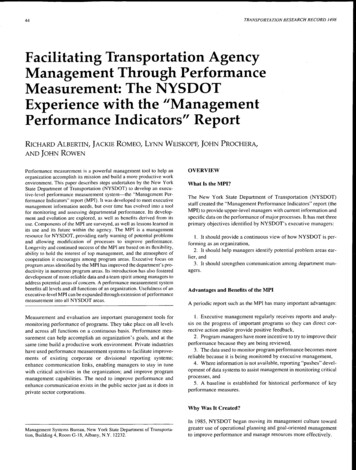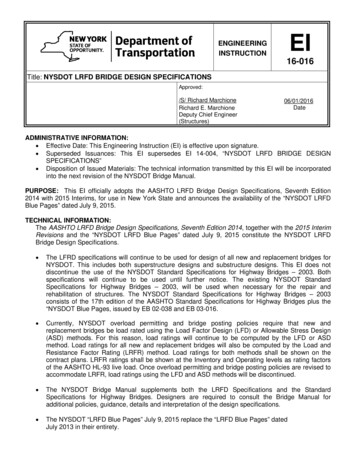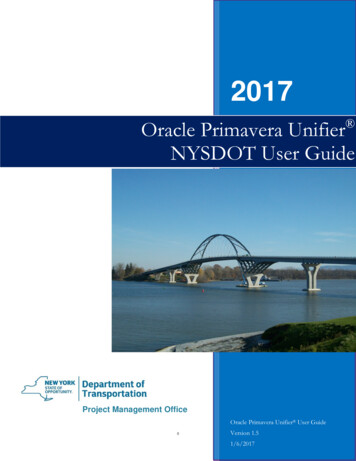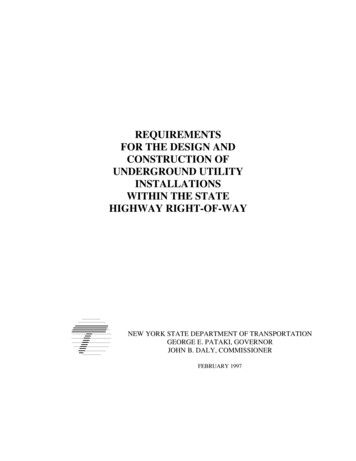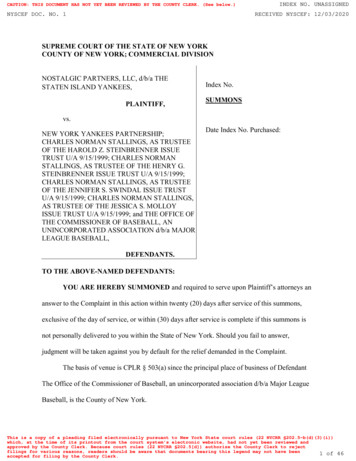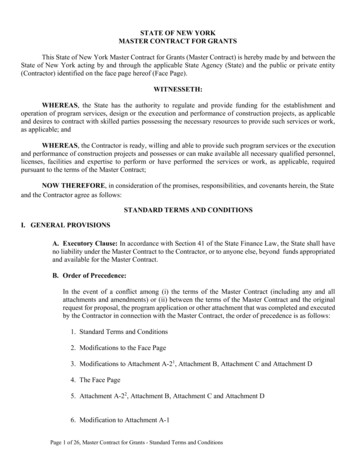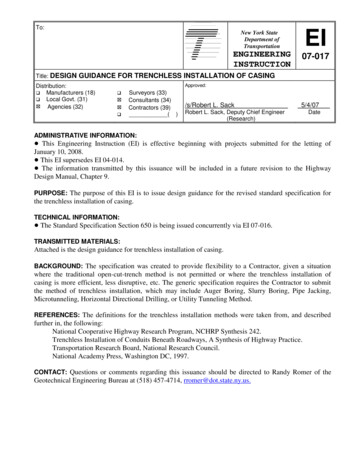
Transcription
To:Title: DESIGNNew York StateDepartment ANCE FOR TRENCHLESS INSTALLATION OF CASINGDistribution: Manufacturers (18) Local Govt. (31) Agencies (32)Approved: Surveyors (33) Consultants (34) Contractors (39) ( )/s/Robert L. Sack5/4/07Robert L. Sack, Deputy Chief Engineer(Research)DateADMINISTRATIVE INFORMATION:! This Engineering Instruction (EI) is effective beginning with projects submitted for the letting ofJanuary 10, 2008.! This EI supersedes EI 04-014.! The information transmitted by this issuance will be included in a future revision to the HighwayDesign Manual, Chapter 9.PURPOSE: The purpose of this EI is to issue design guidance for the revised standard specification forthe trenchless installation of casing.TECHNICAL INFORMATION:! The Standard Specification Section 650 is being issued concurrently via EI 07-016.TRANSMITTED MATERIALS:Attached is the design guidance for trenchless installation of casing.BACKGROUND: The specification was created to provide flexibility to a Contractor, given a situationwhere the traditional open-cut-trench method is not permitted or where the trenchless installation ofcasing is more efficient, less disruptive, etc. The generic specification requires the Contractor to submitthe method of trenchless installation, which may include Auger Boring, Slurry Boring, Pipe Jacking,Microtunneling, Horizontal Directional Drilling, or Utility Tunneling Method.REFERENCES: The definitions for the trenchless installation methods were taken from, and describedfurther in, the following:National Cooperative Highway Research Program, NCHRP Synthesis 242.Trenchless Installation of Conduits Beneath Roadways, A Synthesis of Highway Practice.Transportation Research Board, National Research Council.National Academy Press, Washington DC, 1997.CONTACT: Questions or comments regarding this issuance should be directed to Randy Romer of theGeotechnical Engineering Bureau at (518) 457-4714, rromer@dot.state.ny.us.
TRENCHLESS INSTALLATION OF CASINGGENERALThe intent of the specification is to pay the Contractor for opening a cased hole from one pointto another, as indicated in the contract documents. For instances where a utility is to beinstalled, the item may be used to open a hole/pathway for the placement of the utility carrierpipe.The specification is organized by casing size (XX denotes casing diameter size).1Definitions. The following are definitions of acceptable trenchless installation methods .A. Auger Boring (AB). A technique that forms a bore hole from a drive shaft to a receptionshaft by means of a rotating cutting head. Spoil is transported back to the drive shaft byhelical-wound auger flights rotating inside a steel casing that is being jacked in placesimultaneously. AB may provide limited tracking and steering capability. It does not providecontinuous support to the excavation face. AB is typically a 2-stage process (i.e., casinginstallation and product pipe installation).Figure 9-1a Track-Type Auger Boring System:Figure 9-1b Augers Lifted intoAuger boring machine placed on a track system Entrance Pit.B. Slurry Boring (SB). A technique that forms a bore hole from a drive shaft to a receptionshaft by means of a drill bit and drill tubing (stem). A drilling fluid (i.e., bentonite slurry,water, or air pressure) is used to facilitate the drilling process by keeping the drill bit cleanand aiding with spoil removal. It is a 2-stage process. Typically, an unsupported horizontalhole is produced in the first stage. The pipe is installed in the second stage.EI 07-017Page 1 of 12L 01/10/08
Figure 9-2a Surface Launched SlurryBoring SystemFigure 9-2b Slurry Boring EntrancePoint & Slurry Retrieval Pit.C. Pipe Jacking (PJ). A technique for installing a prefabricated pipe through the groundfrom a drive shaft to a reception shaft. The pipe is propelled by jacks located in the driveshaft. The jacking force is transmitted through the pipe to the face of the PJ excavation. Theexcavation is accomplished, and the spoil is transported out of the jacking pipe and shaftmanually or mechanically. Both the excavation and spoil removal processes require workersto be inside the pipe during the jacking operation.D. Microtunneling (MT). A remotely controlled, guided pipe-jacking process that providescontinuous support to the excavation face. The guidance system usually consists of a lasermounted in the drive shaft communicating a reference line to a target mounted inside theMT machine’s articulated steering head.The MT process provides abilityto controlexcavation face stability by applying mechanical or fluid pressure to counterbalance theearth and hydrostatic pressures.E. Horizontal Directional Drilling (HDD). A 2-stage process that consists of drilling a smalldiameter pilot directional hole along a predetermined path and then developing the pilot holeinto a suitable bore hole that will accommodate the desired utility and then pulling the utilityinto place. The HDD process provides the ability to track the location of the drill bit and steerit during the drilling process. The vertical profile of the bore hole is typically in the shape ofan arc entrapping drilling fluid to form a slurry pathway rather than an open hole. Thisentrapped slurry provides continuous support to the bore hole.EI 07-017Page 2 of 12L 01/10/08
Figure 9-3a Horizontal Directional DrillingEntrance Pit with Dewatering Sump.Figure 9-3b Horizontal Directional DrillingEntrance Pit.F. Utility Tunneling (UT). A 2-stage process in which a temporary ground support systemis constructed to permit the installation of a utility. The temporary tunnel liner is installed asthe tunnel is constructed. Workers are required inside the tunnel to perform the excavationand/or spoil removal. The excavation can be accomplished manually or mechanically.Because trenchless installations are typically specified to minimize/eliminate disturbance to thesurrounding area, the specification dictates monitoring tasks for the Contractor to perform. Asurvey of the existing ground surface along the proposed path of casing installation, prior to thestart of work, will establish baseline data. The trenchless installation process will be closelymonitored during its operation to minimize/eliminate ground movements. The designer shouldensure that the project contains Item 625.01 Survey and Stakeout.If Pipe Jacking or Utility Tunneling is determined to be the method of installation duringconstruction (both the excavation and spoil removal processes require workers to be inside thepipe during the jacking operation), work will proceed in accordance with §107-05 R. ConfinedSpaces and a written confined space plan (addresses prevention of unauthorized entry, type ofhazard, work practices, monitoring, provision for attendant, duties of employees, rescue andemergency medical services, multi-employer operations, and provisions for review procedures).EI 07-017Page 3 of 12L 01/10/08
Trenchless MethodsPersonnel Entry NotRequiredPersonnel EntryRequiredHorizontalEarth ackTypeCradleTypePush RodOpenFaceTunnelBoringPipe RammingRotaryPercussionRoad lingSlurryBoringSlurryNew CuttingMidiMiniMechanicalCutting1Figure 1 Classification Systems for Trenchless MethodsCASING LENGTH, TYPE, AND SIZEThe proposed casing length, type, and size shall be indicated in the contract documents.A. Auger Boring (AB). The auger boring method forms a bore hole from a drive shaft to areception shaft by means of a rotating cutting head. Since augers rotate inside the casing, thecasing and its coating material must resist potential damage from the augers. The typicalcasing pipe is made of steel. If required, the utility carrier pipe may be made of any materialsuitable for the utility being carried. Steel pipe shall be bare steel casing pipe meeting the requirement of ASTM A53, GradeB, Types E or S, or approved equal. The ends shall be prepared for butt welding andbeveled at 37 ½ degrees.B. Slurry Boring (SB). The slurry boring method forms a bore hole from a drive shaft to areception shaft by means of a drill bit and drill tubing (stem). A pilot hole is drilled and checkedfor accuracy. Once confirmed, the pilot hole is reamed to the desired bore-hole diameter and acasing is inserted. Any type of casing can be installed. The casing may be installed by tensionforces, compressive forces or both.EI 07-017Page 4 of 12L 01/10/08
C. Pipe Jacking (PJ). The pipe jacking method installs a prefabricated pipe through theground from a drive shaft to a reception shaft by propelling it by jacks located in the drive shaft.The jacking force is transmitted through the pipe to the face of the PJ excavation. Therefore,the type of casing must be capable of transmitting the required jacking forces from the thrustplate to the jacking shield. Steel casing, reinforced concrete pipe (RCP), or glass-fiberreinforced plastic pipe (GFRP) are the most common types of casing used. Steel pipe shall be bare steel casing pipe meeting the requirement of ASTM A53, GradeB, Types E or S, or approved equal. The ends shall be prepared for butt welding andbeveled at 37 ½ degrees. Reinforced concrete pipe shall meet the requirements of §706-02 Reinforced ConcretePipe for Class V, except that the exterior barrier shall be smooth.D. Microtunneling (MT). The microtunneling method is a remotely controlled, guided pipejacking process. Since the microtunneling process is cyclic pipe jacking process, the discussionon the pipe jacking method applies. Steel casing, reinforced concrete pipe (RCP), or glass-fiberreinforced plastic pipe (GFRP) are the most common types of casing used. Steel pipe shall be bare steel casing pipe meeting the requirement of ASTM A53, GradeB, Types E or S, or approved equal. The ends shall be prepared for butt welding andbeveled at 37 ½ degrees. Reinforced concrete pipe shall meet the requirements of §706-02 Reinforced ConcretePipe for Class V, except that the exterior barrier shall be smooth.E. Horizontal Directional Drilling (HDD). The horizontal directional drilling method consists ofdrilling a small diameter pilot directional hole along a predetermined path and then developingthe pilot hole into a suitable bore hole that will accommodate the desired utility and then pullingthe utility into place. The type of casing is limited to one which can be joined togethercontinuously, while maintaining sufficient strength to resist the high tensile stresses imposedduring the pullback operation. Steel casing or butt-fused, high density polyethylene pipe(HDPE) are the most common types of casing used. Steel pipe shall be bare steel casing pipe meeting the requirements of ASTM A53,Grade B, Types E or S, or approved equal. The ends shall be prepared for butt weldingand beveled at 37 ½ degrees. High Density Polyethylene (HDPE) pipe shall be SDR-9 or SDR-11 and shall meet therequirements of AWWA C906, PPI PE 3408 and ASTM D3350 B PE 345444C.F. Utility Tunneling (UT). The utility tunneling method consists of temporarily supporting thebore with tunnel liner plates to permit the installation of a utility. When a shield is used, thetunnel liner plates shall be designed to withstand the thrust from jacking the shield against thefull front edge of the newly installed tunnel lining. Tunnel liner plates may be manufactured fromsteel or designed as precast concrete.DESIGN DEVELOPMENT3Table 1 provides the designer with an assumption on the potential method of installation basedupon the identified subsurface conditions.1,2Some trenchless installation methods are unsuitable for some diameters. Table 2 providesthe designer with guidance on the potential method of installation for the desired length ofcasing to be installed.1Table 3 provides the designer with an assumption on some productivity rates, limitations andcost estimates to develop an overall cost and schedule for their project.EI 07-017Page 5 of 12L 01/10/08
3MarginalNoUtility e JackingHDDAuger MicrotunnelingSlurry BoringSoft to very soft clays, silts &organic depositsMedium to very stiff clays andsiltsHard clays and highly weatheredshalesVery loose to loose sandsabove watertableMedium to dense sands belowthe watertableMedium to dense sands abovethe watertableGravel & cobbles less than 50100 mm diameterSoils with significant cobbles,boulders and obstructions largerthan 100-150 mm diameterWeathered rocks, marls, chalksand firmly cemented soilsSlightly weathered tounweathered rocksYesAuger BoringGround ConditionsSlurry MicrotunnelingTABLE 1 Ground Conditions and Suitability of Trenchless MethodsGenerally suitable by experienced contractor withsuitable equipment.Difficulties* may occur, some modifications ofequipment or procedure may be required.Substantial problems, generally unsuitable orunintended for these conditions.* Difficulties in certain trenchless installation operations may require corrective solutions which, if notcomprehensively detailed in the contract documents, can add significantly to the projects overall costthrough delays and claims. For example, a low density soil with numerous, loose boulders may resultin failure of many of the trenchless installation methods. A corrective solution may necessitate a soilgrouting operation, which will increase costs dramatically if not originally outlined in the contractdocuments. These situations should be thoroughly examined with the Regional Geotechnical Engineerto determine if trenchless installation is the appropriate mechanism for the installation of the casing.EI 07-017Page 6 of 12L 01/10/08
1,2TABLE 2InstallationMethodAuger Boring(AB)Typical InstallationDiametersAchievable Dia. Range:100 mm to 1500 mmTrenchless Construction TechniquesTypical Installation LengthsTypical project lengths range from 30 mto 91.5 m.Common Dia. Range:200 mm to 900 mmSlurry Boring(SB)Achievable Dia. Range:50 mm to 1200 mmCommon Dia. Range:50 mm to 300 mmPipe Drilling (HDD)UtilityTunneling(UT)EI 07-017Typically, SB is a non-directionallycontrolled process; therefore, the risk ofobtaining an unacceptable pilot holeincreasesgreatlywithdistance.Although the common bore hole spansare approx. 15 m, bore holes longerthan 100 m have been installed by SB.Work SpaceRequirementsEntry & Exit bore pits (8 mto 11 m by 2.5 m to 3.5 m).Working area:9 m by 25 m, includes roomfor storing augers, casing,etc.Entry & Exit bore pits/shafts.Working area:5 m to 10 m by 15 m to 20m, includes room forlaydown space for drill tube,casing,liftingequip.,pumps, drill fluid, etc.Jacking pit is a function ofthe pipe size. Pit sizes varyfrom 3 m to 9 m.Compatible Soil TypesVariety of soil conditions.Firm, stable cohesive material.Wet, noncohesive material canbe accommodated provided thatspecialprecautionsareexercised.Achievable Dia. Range:The length of the PJ drive is determinedStable granular and cohesive1060mmtoNo by the amount of available jackingsoils are best. Unstable sand istheoretical limit.thrust and the compressive strength ofleast favorable. Large bouldersthe pipe. The most common range forcause frequent work stoppage.Common Dia. Range:drive lengths is from 150 m to 305 m. Confined space entry for Method can be executed with1200 mm to 1830 mmNo theoretical limit.hand mining.any ground condition withadequate precautions.Achievable Dia. Range:The most common range for drive Primary Jacking Pit: 4 m Variety of soil conditions,250 mm to 3500 mmlengths is from 150 m to 305 m for long, 3 m wide, smaller including full face rock and highslurry MT and 61 m to 122 m for auger retrieval pit, room for slurry groundwater head.Common Dia. Range:MT.tanks, pipe storage.600 mm to 1200 mmAchievable Dia. Range:Bore lengths can range from 120 m to Entry & Exit pits not Clay is ideal. Cohesionless sand75 mm to 1200 mm1800 m depending on the site required. Space for set up and silt require bentonite.conditions.of rig and drilling fluid tank: Gravelandcobblesare120 m x 60 m.unsuitable.Achievable Dia. Range:No theoretical limit.Person-entry and handmining requires a min.1060 mm dia. tunnel.No theoretical limit.Page 7 of 12Smallersurfacearea Variety of soil conditions.comparedtoPJ(compactnessoflinersystem). Confined spaceentry for hand mining andliner installation.L 01/10/08
1TABLE 3 Productivity Rates, Limitations, and Estimated Costs for Trenchless MethodsInstallationMethodAuger Boring(AB)Productivity Rates*MicroTunneling(MT)It will take a four-person crew 3-4 hr. to set upthe AB equipment for a steel casing project 600mm in diameter utilizing segments 6m in length.A typical production rate for this size project is 30m in an 8-hr shift.SB typically is used for small-diameter, short borelengths. For example, a common size conduit is100 mm with a bore length of 15 m. A two-tothree-person crew can be expected toaccomplish three or four of these drives in aworkday.A reasonable productivity range for PJ projects is9 m to 30 m per shift with a four- or five-personcrew. Factors that can affect productivity includethe presence of groundwater, unanticipatedobstructions such as boulders or other utilities,and changed conditions such as encounteringwet, silty sand after selecting equipment forstable sandy clay.A four- to eight-person MT crew can obtain aproduction rate of 9 m to 18 m per shift.HorizontalDirectionalDrilling (HDD)A three-person HDD crew, in suitable groundconditions, can install a pipeline as long as 180 min a workday.UtilityTunneling(UT)The installation of segmental liners almost alwaysrequires manual operations, The actual tunneladvance is determined by soil conditionsencountered, the method of soil excavation andremoval, liner materials, and the fieldcoordination and skill level of the Contractor.Slurry Boring(SB)Pipe Jacking(PJ)LimitationsCost**Cannot be used in wet, running sands or soils with 0.4- 0.5 per mm oflarge boulders.casing diameter perlinear meter of casing.A major concern with using any type of drilling fluid 0.13- 0.4 per mm ofunder a roadway is the potential for overexcavation.casing diameter perlinear meter of casing.Large boulders cause frequent work stoppage.Hand Mining: 0.77- 1.9 per mm ofcasing diameter perlinear meter of casing.Obstructions are an issue. A special concern that iscritical to the success of an MT project is the abilityto predict and control jacking forces.Not suitable for high degree of accuracy such asgravity sewer application.An HDD operation allows curved bores on casingdiameters under 600 mm but the radius of curvatureis generally not less than 100 times the diameter ofthe casing pipe.Carrier pipe is required to be installed to carry theutility and the annular space between the tunnel linerplates and carrier pipe need to be grouted. 1.7- 2.6 per mm ofcasing diameter perlinear meter of casing.50-250 mm: 16- 160per linear meter.250-600 mm: 160 650 per linear meter.600-1200 mm: 650 1650 per linear meter.Hand Mining: 0.9- 2.1 per mm ofcasing diameter perlinear meter of casing.* Productivity estimate does not include the excavation and shoring of the entrance and exit pits.** Cost estimates given in reference, based on Midwest Cost indices, 1996. Recent bid prices should be reviewed and compared.EI 07-017Page 8 of 12L 01/10/08
SUBMITTAL PROCESSThe trenchless installation of casing specification was created to provide flexibility to aContractor given a situation where the traditional open-cut-trench method is not permitted orwhere the trenchless installation of casing is more efficient, less disruptive, etc. This genericspecification requires the Contractor to submit the method of trenchless installation, which mayinclude the previously defined methods. By accepting various types of trenchless installationmethods, we allow the Contractor to utilize their experience and expertise to decide on theappropriate method to progress through the anticipated subsurface conditions. This places aresponsibility on the Department to define the subsurface conditions. The subsurfaceexplorations must provide enough information to define the engineering characteristics of thesoil and �.To ensure the designed drill path is in compliance with the contract documents duringinstallation, the Contractor is required to submit their proposed steering (e.g. articulatedsteering head, offset jets incorporated into a direction sensing and steering head, etc.) andtracking equipment (e.g. sonde transmitter & receiver, electromagnetic down-hole navigationalsystem, water level line, laser & survey tools, etc.), procedures, and proposed locationsrequiring surface or subsurface access.Figure 9-4a Slurry Boring Tracking Equipment: Figure 9-4b Slurry Boring Tracking:Electromagnetic Down-Hole NavigationalElectromagnetic Down-Hole NavigationalSystem: Tracer Wire Splice.System: Surface Cables.EI 07-017Page 9 of 12L 01/10/08
Figure 9-4a Horizontal Directional DrillingTracking Equipment (Walk-Over Receiver):Vermeer Eclipse Drill Head Locator.Figure 9-4b Horizontal Directional DrillingTracking Equipment (Walk-Over Receiver):Vermeer Eclipse Drill Head Locator.A review of the Contractors submittal of their proposed steering and tracking equipmentprocedures should note that walk-over monitoring systems will require a depth measurement atleast every 1.5 m to 9 m directly over the cutting head, depending on the pipe tolerancesrequired. The maximum depth of walk-over monitoring is often limited to 4.5 m or less.Electromagnetic down-hole navigational systems can be used for deeper depths but is often notas accurate as walk-over monitoring. Overhead wires, concrete rebar and adjacent CMPculverts can interfere with the accuracy of the readings.DESIGNER GUIDANCEGeotechnical Review. The designer should consult with the Regional Geotechnical Engineer(RGE) to ensure adequate subsurface explorations are progressed to verify the feasibility ofinstalling the proposed casing via trenchless methods. The designer and the RGE shoulddiscuss the subsurface conditions (type of soil, groundwater elevation, obstructions, existingutilities, etc.), length of bore, sensitivity of existing aboveground structures, etc., with respect tothe proposed casing type and diameter, to determine the appropriateness of utilizing thespecification.The importance of adequate subsurface explorations cannot be overstated. Since there is noseparate payment for obstructions, the Department must adequately define the subsurfaceconditions if we are to avoid contract disputes.EI 07-017Page 10 of 12L 01/10/08
Subsurface explorations must provide enough information to define the engineeringcharacteristics of the soil and rock. This is important for the Contractor to know what kind ofconditions will be encountered while installing the casing so appropriate methods andequipment can be selected and a reasonable bid submitted.A majority of the trenchless installation methods are potential techniques for progressingthrough full-face bedrock. However, if bedrock is encountered in the subsurface explorations atan elevation in the vicinity of the proposed drill path, revisions may be necessary. A minimumseparation of 1.2 m should be allowed between bedrock and the bottom of the proposedcasing. The designer should investigate installing the casing completely within rock. If thisseparation cannot be achieved, the Regional Geotechnical Engineer should investigate thesubsurface conditions further with close interval subsurface explorations to identify the rocksurface.Utility Review. The specification will pay for the trenchless installation of casing which may beused to install a utility. The designer should consult with the Regional Utilities Engineer (RUE)to discuss the location and type of casing with consideration to the type of utility to be installed.Rails Review. For an installation under a railroad, the designer shall consult with the RailAgreements Section of the Design Services Bureau to identify the appropriate additional itemsfor the track support system:Item 675.77----23 M – Furnishing and Removing Temporary Track Support System.Item 675.7701--23 M –Furnishing, Installing, and Removing Temporary Track SupportSystem.The Railroad (or the Department depending on the site specific subsurface conditions) mayrequire an uninterrupted trenchless installation within the railroad/ roadbed influence zone.Railroad's typically require this operation to progress on a 24-hr basis, without stoppage (exceptfor adding lengths of casing), until the leading edge of the casing has reached the exit pit.Environmental Review. The designer should identify potential impacts the trenchlessinstallation may have on existing environmental and cultural resources and identifywatercourses, wetlands, etc., which may require protection from the cuttings and pit spoilhandling areas and final placement areas of the trenchless installation method.Right-Of-Way Review. The designer should identify potential impacts the trenchlessinstallation may have on existing right-of-way restrictions with respect to the location of theentrance and exit pits. It should be noted that all trenchless installation methods may be pitlaunched. However, some techniques may be surface launched, which may extend the requiredwork space requirements.Health and Safety Review. The designer should consult with the Regional Health and SafetyRepresentative (if appropriate) to discuss potential use of Pipe Jacking or Utility Tunneling andthe applicable safety standards for work in confined spaces. Regional Health and SafetyRepresentative will work with the Regional Construction Safety Coordinator and EIC as atechnical advisor during construction.EI 07-017Page 11 of 12L 01/10/08
REFERENCES1.National Cooperative Highway Research Program, NCHRP Synthesis 242.Trenchless Installation of Conduits Beneath Roadways, A Synthesis of Highway Practice.Transportation Research Board, National Research Council.National Academy Press, Washington DC, 1997.2.California Department of Transportation, Design Information Bulletin No. 83Caltrans Supplement to FHWA Culvert Repair Practices m3.Trenchless Construction Methods and Soil Compatibility Manual, Third Ed.T. Iseley (Iseley Enterprises, Inc.), R. Tanwani (Montgomery Watson), andM. Najafi (Missouri Western State College)Prepared for the National Utility Contractors Association, 19994.Trenchless Construction Methods and Implementation SupportUniversity of Missouri-Columbia and Missouri Department of TransportationOrganizational Results Research Report, R102.003, October 007.pdf5.Pipe Jacking and MicrotunnellingJ. Thomson, Chairman, Jason Consultancy GroupBlackie Academic & Professional, 19936.Requirements for the Design and Construction of Underground Utility InstallationWithin the State Highway Right-of-WayNYS Department of Transportation, February, k.pdfEI 07-017Page 12 of 12L 01/10/08
E. Horizontal Directional Drilling (HDD). A 2-stage process that consists of drilling a small diameter pilot directional hole along a predetermined path and then developing the pilot hole into a suitable bore hole that will accommodate the desired utility and then pulling the utility into place.


